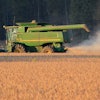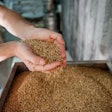
CNannounced that during the week of October 16 (week 12 of the 2022-2023 crop year), it moved over 806,000 metric tonnes of grain from Western Canada, exceeding its previous record by over 50,000 metric tonnes.
This record also comes on the heels of CN’s second best September ever for grain movement from Western Canada, with over 2.64 million metric tonnes moved.
“We are very proud to have set a new record for the amount of Western Canadian grain moved in a single week," said Doug MacDonald, chief marketing officer. "We are confident that our railroaders will continue delivering results for Canadian farmers and all of our customers.”
Canadian grain was piling amid rail bottleneck
In the first week of October, it was reported thatCanada's bumper crop may have problems being transportedas there weren't enough cars to fill orders.
There were almost 2,400 outstanding grain-car orders for the nation’s two major carriers,Canadian National Railway Co.(CN) andCanadian Pacific Railway Ltd.(CP), according to data from theAg Transport Coalition.
That’s the worst backlogsince flooding blocked access to Vancouver’s portin late 2021, stranding wheat and canola in the Prairies.
At the time, CN toldBloombergthat a two-day washout on a section of the railway’s network disrupted certain supply chains, but the company has resources in place to move anticipated grain volumes over the course of the current crop year.
Branch line reopened
On October 5, a bridge fire shut down a CN branch line in Northern Alberta.
CN’s engineering team worked around the clock and a little over a week later the track was reopened, getting grain, lumber and other products back on the move.
The team mobilized the equivalent of 20 Olympic-size swimming pools of material to fill in where a bridge once stood.
CN plan for winter
CN’s recently published 2022-2023Winter Planprovides more information on the wide range of initiatives CN has put into place to ensure it has the capacity and resources to respond safely and efficiently to the needs of customers in the coming winter months.





















